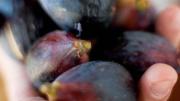New archaeobotanical evidence pushes the dawn of agriculture back to 11,400 years ago, when humans living in a village eight miles north of ancient Jericho began propagating seedless figs. Ofer Bar-Yosef, professor of anthropology and curator of Paleolithic archaeology at Harvards Peabody Museum, published the findings recently in the journal Science, along with coauthors Mordechai E. Kislev and Anat Hartmann of Bar-Ilan University in Israel.
The figs, nine still whole among more than 300 smaller pieces, were found in the ruins of a burned house at Gilgal 1. The fire permitted reliable dating of the site, and had the further desirable effect—from an archaeologist’s perspective—of carbonizing and preserving the fruits. The figs proved to be a variety that grows only on sterile female trees, which occur occasionally in the wild as a result of genetic mutation. They bear soft, sweet, edible fruit, but cannot reproduce except from shoots, making them an evolutionary dead end. With human intervention, however, stems cut from fig trees and planted in soil will root fairly easily.
Another cache of figs, found 1.5 kilometers away at the Netiv Hagdud site, proved to be the same mutant variety. Humans must have recognized that the fruits do not produce new trees, and fig-tree cultivation became a common practice, says Bar-Yosef. Previously, the domestication of grains and legumes a thousand years later had been considered the earliest evidence of the momentous shift in human history from hunting and gathering to a more sedentary lifestyle.
Because they produce three crops a year, figs made an ideal staple food. They have been found at numerous Neolithic sites in the Jordan Valley, along with acorns and wild varieties of wheat, barley, and oats, says Bar-Yosef, indicating that the subsistence strategy of these early farmers was a mixed exploitation of wild plants and initial fig domestication. He and his colleagues suggest that ease of planting, along with an improved taste resulting from minor mutations, may explain why figs were domesticated 5,000 years before grapes, olives, or dates.
~Jonathan Shaw
Ofer Bar-Yosef e-mail address: obaryos@fas.harvard.edu






